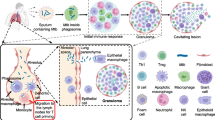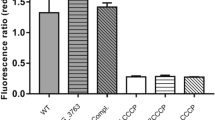Abstract
The spread of drug-resistant strains of Mycobacterium tuberculosis is a major threat to the global control of tuberculosis (TB), urging the need to constantly develop new anti-TB drugs. Tryptanthrins are convenient compounds for the development of candidate anti-TB drugs due to the easy synthesis, low toxicity, and antimycobacterial activity on both drug-susceptible and drug-resistant M. tuberculosis strains. Enoyl-acyl carrier protein reductase InhA was previously predicted in silico as a possible target for tryptanthrins, while spontaneous tryptanthrin-resistant M. smegmatis mutants were found to have mutations in the MSMEG_1963, MSMEG_4427, and MSMEG_5597 genes. Using the approaches of reverse genetics, we demonstrate that mutations in the MSMEG_1963 and MSMEG_5597 genes lead to a loss of function of their encoded transcriptional repressors and lead to resistance to tryptanthrins. We show that mutations in MSMEG_1963 and MSMEG_5597 lead to overexpression of MSMEG_1964 and MSMEG_5596, respectively, which encode enzymes potentially involved in redox inactivation of tryptanthrins. We also show that InhA is not a biotarget of tryptanthrins, as its overexpression does not affect susceptibility of mycobacteria to tryptanthrins.


Similar content being viewed by others
REFERENCES
World Health Organization, Global Tuberculosis Report 2020, Geneva: WHO, 2020.
Hinshaw, H.C., Pyle, M.M., and Feldman, W.H., Streptomycin in tuberculosis, Am. J. Med., 1947, vol. 2, no. 5, pp. 429—435. https://doi.org/10.1016/0002-9343(47)90087-9
British Thoracic Society, A controlled trial of 6 months’ chemotherapy in pulmonary tuberculosis final report: results during the 36 months after the end of chemotherapy and beyond, Brit. J. Dis. Chest., 1984, vol. 78, pp. 330—336. https://doi.org/10.1016/0007-0971(84)90165-7
Hameed, H.M.A., Islam, M.M., Chhotaray, C., et al., Molecular targets related drug resistance mechanisms in MDR-, XDR-, and TDR-Mycobacterium tuberculosis strains, Front. Cell. Infect. Microbiol., 2018, vol. 8, pp. 1588—1521. https://doi.org/10.3389/fcimb.2018.00114
Islam, M.M., Hameed, H.M.A., Mugweru, J., et al., Drug resistance mechanisms and novel drug targets for tuberculosis therapy, J. Genet. Genomics, 2017, vol. 44, no. 1, pp. 21—37. https://doi.org/10.1016/j.jgg.2016.10.002
Coxon, G.D., Cooper, C.B., Gillespie, S.H., and McHugh, T.D., Strategies and challenges involved in the discovery of new chemical entities during early-stage tuberculosis drug discovery, J. Infect. Dis., 2012, vol. 205, suppl. 2, pp. S258—S264. https://doi.org/10.1093/infdis/jis191
Mitscher, L.A. and Baker, W., Tuberculosis: a search for novel therapy starting with natural products, Med. Res. Rev., 1998, vol. 18, no. 6, pp. 363—374. https://doi.org/10.1002/(sici)1098-1128(199811)18:6<363::aid-med1>3.0.co;2-i
Honda, G. and Tabata, M., Isolation of antifungal principle tryptanthrin, from Strobilanthes cusia O. Kuntze, Planta Med., 1979, vol. 36, no. 5, pp. 85—86. https://doi.org/10.1055/s-0028-1097245
Bhattacharjee, A.K., Skanchy, D.J., Jennings, B., et al., Analysis of stereoelectronic properties, mechanism of action and pharmacophore of synthetic indolo[2,1-b]quinazoline-6,12-dione derivatives in relation to antileishmanial activity using quantum chemical, cyclic voltammetry and 3-D-QSAR CATALYST procedures, Bioorgan. Med. Chem., 2002, vol. 10, no. 6, pp. 1979—1989. https://doi.org/10.1016/s0968-0896(02)00013-5
Bhattacharjee, A.K., Hartell, M.G., Nichols, D.A., et al., Structure-activity relationship study of antimalarial indolo[2,1-b]quinazoline-6,12-diones (tryptanthrins): three dimensional pharmacophore modeling and identification of new antimalarial candidates, Eur. J. Med. Chem., 2004, vol. 39, no. 1, pp. 59—67. https://doi.org/10.1016/j.ejmech.2003.10.004
Bandekar, P.P., Roopnarine, K.A., Parekh, V.J., et al., Antimicrobial activity of tryptanthrins in Escherichia coli, J. Med. Chem., 2010, vol. 53, no. 9, pp. 3558—3565. https://doi.org/10.1021/jm901847f
Kataoka, M., Hirata, K., Kunikata, T., et al., Antibacterial action of tryptanthrin and kaempferol, isolated from the indigo plant (Polygonum tinctorium Lour.), against Helicobacter pylori-infected mongolian gerbils, J. Gastroenterol., 2001, vol. 36, no. 1, pp. 5—9. https://doi.org/10.1007/s005350170147
Honda, G., Tosirisuk, V., and Tabata, M., Isolation of an antidermatophytic, tryptanthrin, from indigo plants, Polygonum tinctorium and Isatis tinctoria, Planta Med., 1980, vol. 38, no. 3, pp. 275—276. https://doi.org/10.1055/s-2008-1074877
Tripathi, A., Wadia, N., Bindal, D., and Jana, T., Docking studies on novel alkaloid tryptanthrin and its analogues against enoyl-acyl carrier protein reductase (InhA) of Mycobacterium tuberculosis, Indian J. Biochem. Biophys., 2012, vol. 49, no. 6, pp. 435—441.
Banerjee, A., Dubnau, E., Quemard, A., et al., inhA, a gene encoding a target for isoniazid and ethionamide in Mycobacterium tuberculosis, Science, 1994, vol. 263, no. 5144, pp. 227—230.
Frolova, S.G., Klimina, K.M., Kumar, R., et al., Identification of mutations conferring tryptanthrin resistance to Mycobacterium smegmatis, Antibiotics, 2021, vol. 10, no. 1, pp. 6—10. https://doi.org/10.3390/antibiotics10010006
Shur, K.V., Frolova, S.G., Akimova, N.I., et al., A test system for in vitro screening antimycobacterial drug candidates for MmpS5-MmpL5 mediated resistance, Russ. J. Genet., 2021, vol. 57, no. 1, pp. 114—116. https://doi.org/10.1134/S1022795421010154
Blokpoel, M.C.J., Tetracycline-inducible gene regulation in mycobacteria, Nucleic Acids Res., 2005, vol. 33, no. 2. e22. https://doi.org/10.1093/nar/gni023
Goude, R. and Parish, T., Electroporation of Mycobacteria, vol. 1285 of Mycobacteria Protocols: Methods in Molecular Biology, Parish T. and Brown A., Eds., Totowa, NJ: Humana Press, 2009, vol. 465, рр. 203–215.https://doi.org/10.1007/978-1-59745-207-6_13
Parish, T. and Stoker, N.G., Use of a flexible cassette method to generate a double unmarked Mycobacterium tuberculosis tlyA plcABC mutant by gene replacement, Microbiology (Reading, England), 2000, vol. 146, part 8, pp. 1969—1975.
Ye, J., Coulouris, G., Zaretskaya, I., et al., Primer-BLAST: a tool to design target-specific primers for polymerase chain reaction, BMC Bioinf., 2012, vol. 13, no. 1, p. 134. https://doi.org/10.1186/1471-2105-13-134
Hwang, J.-M., Oh, T., Kaneko, T., et al., Design, synthesis, and structure-activity relationship studies of tryptanthrins as antitubercular agents, J. Nat. Prod., 2012, vol. 76, no. 3, pp. 354—367. https://doi.org/10.1021/np3007167
Li, X., Mei, H., Chen, F., et al., Transcriptome landscape of Mycobacterium smegmatis, Front. Microbiol., 2017, vol. 8, p. 2505. https://doi.org/10.3389/fmicb.2017.02505
ACKNOWLEDGEMENTS
We are grateful to D.B. Salunke (Department of Chemistry and Centre of Advanced Studies in Chemistry, Panjab University, India) and P. Kendrekar (Unit for Drug Discovery Research, Department of Health Sciences, Central University of Technology, South African Republic) for providing tryptanthrin compounds for the studies.
Funding
This work was supported by a grant from the President of the Russian Federation for young Russian scientists—candidates of sciences, MK-797.2020.4.
Author information
Authors and Affiliations
Corresponding author
Ethics declarations
The authors declare that they have no conflicts of interest. This article does not contain any studies involving animals or human participants performed by any of the authors.
Additional information
Translated by A. Lisenkova
Rights and permissions
About this article
Cite this article
Frolova, S.G., Danilenko, V.N. & Maslov, D.A. MSMEG_1963 and MSMEG_5597 Genes, but Not inhA, Modulate Mycobacterium smegmatis Resistance to Tryptanthrins. Russ J Genet 58, 1051–1058 (2022). https://doi.org/10.1134/S1022795422090083
Received:
Revised:
Accepted:
Published:
Issue Date:
DOI: https://doi.org/10.1134/S1022795422090083




